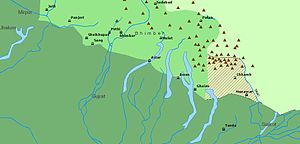Battle of Chamb
| Battle of Chamb | |||||||
|---|---|---|---|---|---|---|---|
| Part of the Indo-Pakistani War of 1971 | |||||||
 Chamb. Hatched Area captured by Pakistan during the Indo-Pakistani War of 1971 in the Western Theater. |
|||||||
|
|||||||
| Belligerents | |||||||
|
|
|
||||||
| Commanders and leaders | |||||||
|
|
Unknown | ||||||
| Casualties and losses | |||||||
| 6 dead 80 wounded 4 tanks and several military vehicles destroyed |
72 dead 15 wounded 45 square miles (120 km2) of territory lost Several military vehicles and tanks captured or destroyed |
||||||
The Battle of Chamb, 1971 was battle in the Indo-Pakistani War of 1971. The Pakistani Army invaded Chamb on the same principle as the Battle of Chamb (1965). The Pakistan Army's primary objective was to capture the town of Chamb and surrounding areas which had strategic importance for both Pakistan and India. Previously, in 1965, the Pakistani Army was able to reach further beyond Chamb and was threatening Akhnur, a vital medium-sized town. India had captured Hajipir pass and made substantial progress in the Hajipir pass area in 1965, a key strategic location which the Pakistani Army had captured at the end of the 1947-48 Kashmir War. The Hajipir pass connects Uri and Poonch. Pakistan regained possession of the Hajipir pass during Tashkant agreement, an area the country still controls today.
Before the capture of Chamb by Pakistan forces, this western sector was under India's control. Similar to 1965, plans were made to capture this strategic town. The reason behind this plan was to deter Indians from attacking the crucial north-south line of communications passing via Gujrat. The 23 Division of Pakistan was given the task of protecting this sector and later attacking the Chamb-Dewa sectors. On the Indian side, 10 Division was given the task of defence of Chamb; the Indian army believed that by attacking Gujrat and Tanda, they could guarantee the defence of Chamb. In comparison to 1965, the Indians were better prepared in terms of defences and now realized the importance of the town and sector.
The battle ended, with the Pakistan Army taking control of Chamb. Pakistan gained about 45 square miles (120 km2) of Indian territory. The Indian Army put up stiff resistance at Mandiala and at several defensive features. Indian army withdrew when it realised Chamb could not be held defended. Across the Tawi, 4 Indian field guns were left unmanned after the last Indian Sikh soldier was killed by a Pakistani soldier of Bengali origin. Four Pakistani tanks were destroyed earlier in the battle, after which Pakistani Commander Major General Eftikhar Khan moved his forces from the south through Chak Pandit, all the time keeping pressure on the Indians from the north. This threatened to overrun the Indian forces, and they reluctantly fell back. The whole process came to a full stop on 10th December when the helicopter carrying Major General Eftikhar the indomitable GOC of the division was shot down, he was severely wounded and was evacuated to CMH Kharian where he died later. At this stage the Indian 10 Division had strong reserves which were uncommitted i.e an infantry brigade which was free after capturing the Phulkean Salient and the 3rd Armoured Brigade comprising 8th Light Cavalry (Vijayanta) and Central India Horse (T-55).However in case Pakistan’s 23 Division had captured a foothold across Tawi.These Indian reserves would have become committed. But nonetheless due to his excellent military planning, the Pakistani Forces were able to capture Chamb. Several Indian military vehicles were found that had been left behind by retreating Indian army.
...
Wikipedia
